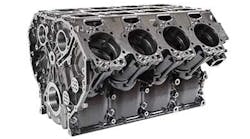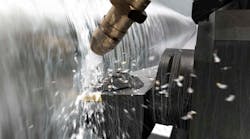Treating machines, tooling, and coolant as an integrated system is the only way to optimize machining operations.
ChipBlaster's Metalworking Process Management (MPM) system uses a computer to control coolant concentration levels, temperature, and delivery. This system will be on display at IMTS 98 in booth E12495.
A schematic of one of ChipBlaster's boring bars shows how its nozzle is designed to be part of the tool. This places coolant precisely on the tool/workpiece interface. The company says this design can improve boring operations by as much as 300%.
Process is everything, believes Gregory Antoun, president of ChipBlaster Ltd., Meadville, Pa. "Spectacular improvements in productivity are possible when everything in a process is optimized," he claims. "Every time we reduce the process variability of one element, we have the opportunity to reduce the process variability of many other elements." Where he believes that optimization is essential, but often overlooked, is in the coolant system of a machine tool.
"Why does a $500,000 horizontal milling machine come with a bucket and shovel?" asks Antoun. "Because in most shops coolant is still handled the way it was 50 years ago," he remarks. "The coolant level and concentration are functionally 'uncontrolled.' What is meant by uncontrolled is that an operator typically carries a five-gallon bucket to a coolant drum, adds an unmeasured amount of coolant concentrate to the bottom of the bucket, and then fills it with water. This usually happens when the operator notices that the coolant is too thick to cool the part or when the coolant is too thin to prevent rust. Process control to monitor the coolant concentration or delivery is lacking."
Computerized coolant concentration
It is estimated that coolant concentration is wrong roughly 80% of the time. For this reason, Chip-Blaster has developed a computerized system that automatically monitors coolant level and concentration and refills the coolant concentrate and water, returning both elements to appropriate levels and to a correct mixing ratio.
In addition to monitoring coolant concentration, the MPM (Metalworking Process Management) system also measures temperature, pH, and conductivity to keep the coolant within a half percent of the pre-programmed target without operator intervention.
According to Antoun's calculations, computerized control of the coolant concentration reduces process variability by over 95%. Optimizing coolant concentration means that coolant does not need to be changed, reducing downtime on the machine. It also means that its chemistry is predictable, which lets operators optimize their cutting operations.
Automating chip removal
Antoun believes that many companies have also taken the wrong approach to chip removal. "Commonly, a conveyor catches large chips, while smaller particles of metal waste collect in the coolant reservoir," says Antoun. "A screen typically prevents these fine particles from clogging the coolant pump." However, this type of system requires frequent maintenance. Operators have to clean the screen and shovel chips out of the coolant reservoir. "We're back to the guy with the shovel and bucket," laughs Antoun.
Although some companies might opt for a magnetic chip conveyor to remove ferrous particles from the coolant stream, Antoun points out these, too, have to be manually cleaned. And, he adds, the practice of using high volumes of coolant to flush chips out of a machine tool doesn't supply adequate force to remove all of the chips. "The result is a bacteria-laden layer of sludge," states Antoun. "These anaerobic bacteria produce acids and other things that change and break down the coolant chemistry. This layer of gunk has literally billions of little critters that immediately contaminate any fresh coolant added to the sump."
For these reasons, ChipBlaster's MPM system uses high-pressure jets in the sump of the machine to clean out chips. A computer turns on the appropriate jets to force chips and small particles sequentially through the system to a collection point such as a vortex pump.
Jets are positioned to efficiently manipulate chips around corners and through tight areas, keeping the machine sump clean regardless of its shape. In addition, the clean-out sequence can be varied to suit the requirements of the type of machining operation, material, cycle, or so forth.
The jets are programmable at the coolant system or machine-tool control. Operators can fire jets at any time, for any length of time, and in any order or preset different cleaning patterns for individual machining programs.
According to Antoun, computer control of the coolant sump completely eliminates down time from clean out and reduces process variability due to anaerobic sludge by at least 90%.
Temperature variation
The next area where process control makes a big difference, reports Antoun, is in temperature variation of the coolant and workpiece. Using standard low-pressure coolant systems causes coolant to boil away before it reaches the chip/tool interface, he says. And what doesn't boil away can't penetrate the super-heated steam barrier that forms.
ChipBlaster's system over-comes these obstacles by combining a computerized, high-pressure coolant delivery system with the appropriate tooling. The system can slash the temperature variation at the cutting edge from over 3,000° to less than 200°. And, by reducing the temperature variation by over 90%, tools cut faster and more reliably.
"Carbide manufacturers have been in a race to develop substrates and coatings resistant to high temperatures," Antoun remarks. "If heat wasn't such a problem, carbide manufacturers could concentrate on edge strength and abrasion resistance, which has a dramatic effect on cutting tool geometry and chemistry. Sharp edges would be okay again, because tools wouldn't build up excessive heat and burn."
Besides cutting metal faster and more reliably, controlling the coolant temperature also provides safety and environmental benefits, says Antoun. "When temperature is controlled, shops don't have to add potentially carcinogenic chemicals to coolant."
However, just reducing the coolant temperature is not enough, asserts Antoun; companies shouldn't expose their work-ers to coolant mist at all. And here, again, shops benefit from an automated systems approach. "First of all, machine tools must be fully enclosed, and during operation, they should have a negative pressure sufficient to prevent any mist from escaping when work-envelope doors are opened to change parts," says Antoun.
"Fortunately, ChipBlaster has developed a new, programmable generation of mist collectors can read the end of a cycle and automatically accelerate the rate of mist removal to protect the operator. Ironically, this equipment delivers a tenfold improvement in air quality, without costing more than old, unreliable technology."
Tooling and toolholders
Perhaps the greatest problem in machining involves hitting the cutting edge with the coolant. "With standard tooling, the challenge is so great that many manufacturers have decided to totally eliminate the process through dry machining operations," says Antoun. The real solution, he says, is to control the application of coolant.
"I can't emphasize this enough—standard tooling has absolutely no provision for coolant; there is no process. In fact, the coolant may not even hit the part. Operators manually adjust snap-together plastic beads, and during operation, these lines are frequently pushed out of alignment. And almost every time an operator changes a part, he has to manually re-adjust the aim of the coolant."
For all of these reasons, Chip-Blaster has engineered process control into its tooling and tool-holders. The company has introduced a new turning system that includes carbide inserts optimized specifically for high-pressure coolant. In addition, the system incorporates a unique nozzle design into its toolholder to ensure that coolant always hits the insert at the optimal spot. Again, states Antoun, this is a process solution, eliminating the need for operator intervention and ensuring the repeatability of the process from setup to setup and throughout a production run.
System validationFraunhofer Resource Center of Massachusetts recently validated Chip-Blaster’s new MPM coolant delivery system. Designed to eliminate positioning error and delivery inefficiency, the new system incorporates a proprietary nozzle design and a custom-made cooling unit that combine to introduce lubricant to the cutting zone at high volume and pressures. The result is a delivery system, which is precisely aimed, repeatable, and effective. A series of tests conducted on a Haas HL-2 turning center compared cutting performance with and without the coolant system. Fraunhofer selected aluminum, 4140 steel, and Inconel 718 as cutting materials. The turning tool was set up with a solid carbide insert, spec. C2 CB 737 CNMG -432. 4140. Cutting steel in dry conditions, at a feedrate of 0.25 ipm, d.o.c. of 1 mm, and a cutting speed of 1,000 sfm, researchers noted a tool life of 443 feet. They also observed that chips formed in a spiral configuration at an average length of 5 in. Using the same machine parameters, and introducing coolant at 880 psi, researchers were able to increase tool life to more than 5,880 feet, a 13-fold improvement. The second test produced very small, slightly curled chips, averaging 0.125 in. in length. |








